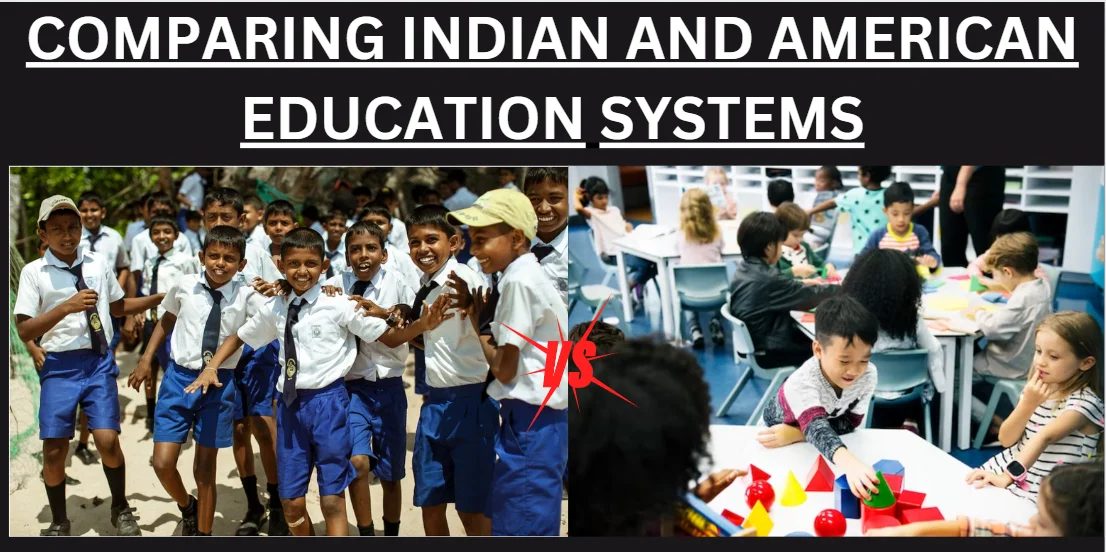
Update: This article was last updated on 11th November 2024 to reflect the accuracy and up-to-date information on the page.
The ongoing debate regarding which education system is more challenging, Indian or American, has long intrigued both Non-Resident Indians (NRIs) and Indians alike. Your role in this debate is crucial. However, determining a definitive answer to this question is far from simple, as it is not a matter of black and white. The rigor of education in each country varies across different areas, with certain aspects favoring the Indian education system while others lean toward the American education system. This comparative analysis often raises questions such as, “Is the Indian education system harder than the American?” or “Is the US education better than India?”. Your insights and perspectives can contribute significantly to this discussion.
One key differentiating factor between the two systems lies in their respective learning methodologies. Until 2020, Indian education significantly emphasized rote learning, a memorization technique primarily reliant on repetition. This approach can lead to a strong memory but may not necessarily foster critical thinking skills. Conversely, the American education system prioritizes hands-on learning, encouraging students to engage actively in the learning process. This approach can enhance problem-solving skills and creativity. These different methodologies have implications for American school years and grade structures, which vary considerably from the Indian model. To answer questions like “Is American education harder than Indian?” or “How does the US education system compare to India?”, we must consider these specific aspects of each system.
To better understand these educational systems, it is essential to conduct a comparative analysis of various parameters. By examining specific aspects, we can shed light on the strengths and weaknesses of each system, allowing for a more nuanced perspective on the USA vs. India education system. This nuanced perspective is crucial in understanding the complexities of these systems and their impact on students.
| Aspect | Indian Education System | American Education System |
|---|---|---|
| Learning Methodology | Emphasizes rote learning, reliant on repetition | Prioritizes hands-on learning, encourages active engagement |
| Subject Combinations | Stringent subject options | Flexible subject options |
| Technology | Developing education system | Top-notch technological facilities across all disciplines |
| Cost of Study | Affordable cost of study for middle-class students | Education costs are extremely high in comparison to the Indian institutes |
| School System | New National Education Policy (NEP) 2020, 5+3+3+4 structure | Divided into three levels |
| Class Sizes and Dress Code | A higher number of students per class, significant importance on uniforms | A lower number of students per class, a flexible dress code |
| Assessments and Exams | Formal exams even at the elementary level, primarily rote learning | Integrates exams into teaching, with more emphasis on creativity |
| Grading and Study Approaches | Board exams, multiple textbooks, final scores for higher studies | GPA system, continuous assessment, comprehensive grading |
| Textbooks and Study Materials | Multiple books carried to school, heavy emphasis on homework | Fewer books carried, practical applications, real-world problems |
School System
India has introduced the new National Education Policy (NEP) 2020, replacing the traditional 10+2 schooling system with a more comprehensive 5+3+3+4 structure. The aim is to ensure inclusivity, critical thinking, and holistic development and equip students with 21st-century skills by nurturing their creativity, problem-solving abilities, and adaptability, preparing them for the evolving global landscape.
5 years = Foundation Stage Age group: 3 to 8 years Classes: Anganwadi/pre-school, Grades 1 & 2 Method: Play-based/activity-based teaching methods focus on language skills. |
3 years = Preparatory Stage Age Group: 8 to 11 years Classes: Grades 3rd to 5th Method: Play and activity-based teaching with a focus on language development and numeracy skills. |
3 Years = Middle Stage Age Group: 11 to 14 Classes: Grades 6 to 8 Method: Experiential learning in the sciences, mathematics, arts, social sciences, and humanities. The focus will be on critical learning objectives, which is a big shift from the rote learning methods. |
4 Years = Secondary Stage Age Group: 14 to 18 For classes: 9 to 12 Method: This stage will cover two phases: Classes 9 and 10, and classes 11 and 12. Concepts will be covered in greater depth in this stage. |
American School System
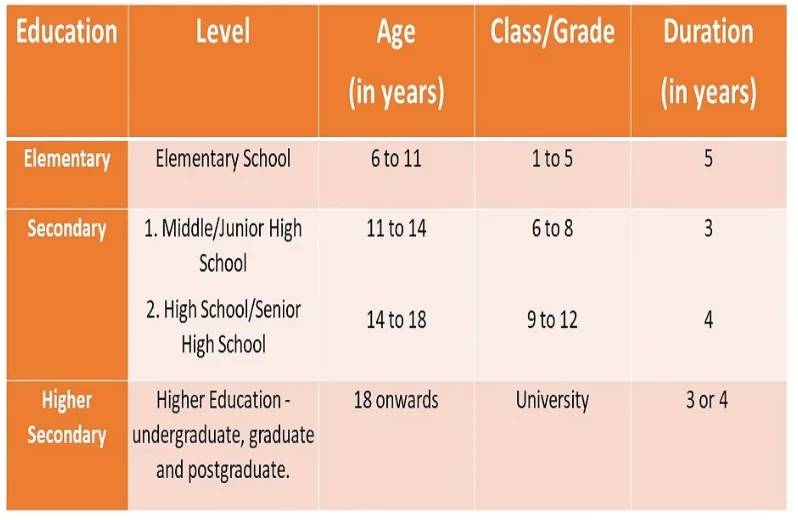
The school education pattern is divided into three levels:
The elementary school Age group: 5 to 10 years Grades: Kindergarten to 5th |
The middle school Age Group: 11-13 years Grades: 6th to 8th |
High school Age Group: 14 to 18 Grades: 9th to 12 |
Subject Combinations
Indian education traditionally emphasizes a rigid curriculum, with students specializing in science, commerce, or humanities from a young age. This early specialization, while fostering depth in chosen fields, can limit exposure to other disciplines and stifle critical thinking skills. In contrast, the American education system offers a more flexible approach, allowing students to explore a broader range of subjects before choosing a major. This flexibility during the American school years encourages interdisciplinary learning and fosters a more well-rounded perspective. The differences between the US education system and India lead some to ask, “Is the Indian education system harder than the American?” or “Is American education harder than Indian?” The answer often depends on one’s perspective, as each system presents its unique challenges.
However, the tide is turning in India. The National Education Policy (NEP) 2020, a significant reform, aims to introduce a more flexible system, with students choosing subjects from a wider pool, including vocational and arts options. This progressive move towards a more American-style approach could bridge the gap in subject combinations and better prepare students for a diverse job market, fueling the discussion of the USA vs. India education system. As the NEP rolls out, it promises to address the long-standing question of ‘Is US education better than India?’ by promoting a curriculum that fosters both specialization and versatility, instilling a profound sense of hope and optimism in the future of Indian education.
Technology
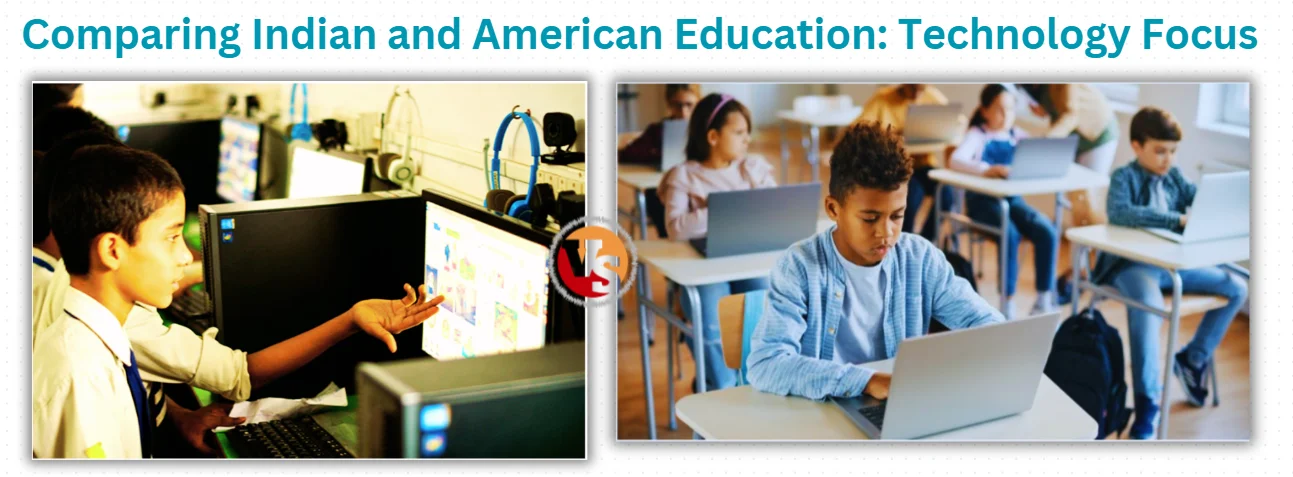
Technology plays a crucial role in modern education, and both systems are actively integrating it into the learning process. In terms of American school years, American schools are better equipped with advanced technology, from interactive whiteboards to virtual reality experiences. However, India is catching up rapidly, with initiatives like the “Digital India” program promoting digital literacy and infrastructure development in schools. Nevertheless, the digital divide remains a significant challenge in India, affecting the US education system vs. India debate, as unequal access to technology and internet connectivity in rural areas hinders the effectiveness of technology-based learning. American schools, while better equipped in the USA vs. India education system, often face the need to help effectively integrate technology into the curriculum and ensure equitable access for all students.
Cost of Study

The cost of education is a major factor shaping student choices and life trajectories. American school years can be notoriously expensive, with tuition fees often exceeding annual incomes in many countries. The American education system vs Indian highlights a contrast in affordability, with India boasting a more accessible system due to government-funded institutions that offer subsidized education. However, quality can vary in both systems; private institutions in India often charge high fees for premium education, intensifying the US education system vs India debate. The cost disparity also extends to living expenses and associated costs.
Students in the US often face significant debt burdens, while Indian students may struggle to afford quality education despite lower fees. Both systems require careful financial planning and scholarship opportunities to ensure access to quality education for all, and the discussion of “Is the Indian education system harder than American,” “Is African education harder than Indian,” or “Is education better than India?” continues in various circles, reflecting ongoing comparisons.
Class Sizes and Dress Codes
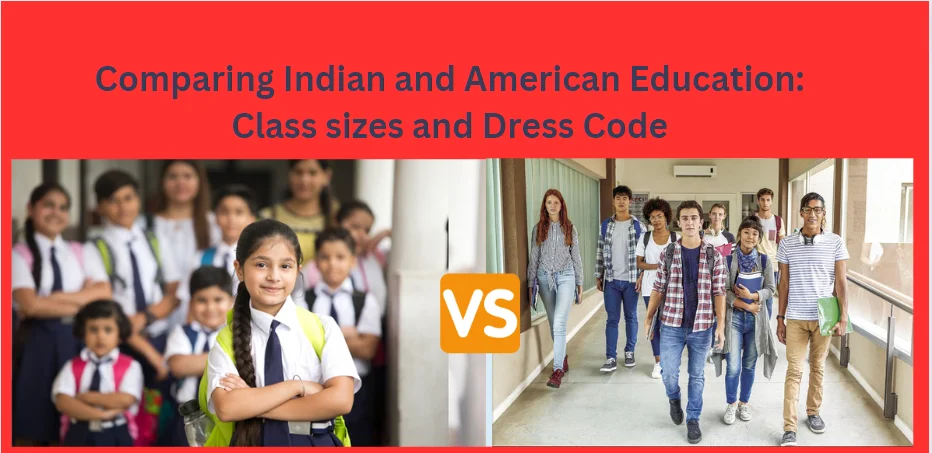
In Indian schools, the number of students per class is considerably higher compared to American schools, reflecting a notable difference in classroom sizes when considering the American school year structure. Additionally, uniforms hold significant importance in Indian schools, while in the United States, the majority of schools have a flexible dress code. This highlights a cultural difference between the American education system and the Indian approach, where Indian schools emphasize uniformity. In contrast, the USA vs. The Indian education system contrasts more flexible individuality in attire.
This difference leads some to wonder if the Indian education system is more complex than American education due to larger class sizes and stricter regulations or if American education is harder than Indian education due to other factors. Both systems offer unique benefits, leaving debates on whether US education is better than India open for discussion.
Assessments and Exams
The ongoing debate of the USA vs. India education system reflects these fundamental differences in approach, keeping the audience engaged and part of a larger conversation about education systems. The Indian education system introduces formal exams even at the elementary school level, resulting in heightened stress for students and parents. Until recently, Indian exams primarily relied on rote learning, with limited emphasis on creative thinking and experiential learning. In contrast, the American education system prioritizes creative scores, integrating exams into regular teaching in lower grades. American school years focus on fostering critical thinking from an early age, unlike the Indian education system, which often emphasizes memorization. In middle schools within the US education system, exams may only be mid-term or end-of-year, with no need for extensive advanced preparation, making some wonder: is the Indian education system harder than the American system? In high schools in the United States, students take exams at the end of each semester or specific subject tests, allowing ample time for preparation. Many ask if US education is better than India’s or if American education is harder than Indian education. The ongoing debate of the USA vs. India education system reflects these fundamental differences in approach.
Moreover, the American education system fosters ‘soft skills‘ such as communication, teamwork, problem-solving, and ‘holistic growth, ‘which refers to the development of a student’s overall personality and not just academic skills. This focus on soft skills and holistic growth may lead to weaker performance in specific subjects. In contrast, Indian counterparts often receive more specialized education.
Contrasting Grading and Study Approaches
The grading and study methodologies in the American and Indian education systems showcase notable differences. While the American system employs a Grade Point Average (GPA) and continuous assessment, the Indian system relies on board exams and emphasizes carrying multiple textbooks to school. The American education system’s grading revolves around the GPA or Grade Point Average. Students’ performances are continuously and comprehensively assessed from 9th to 12th grade. This ‘continuous assessment’ includes regular tests, quizzes, and homework, and the grades obtained from these assessments are factored into the final GPA.
In terms of American school years, students are assessed continuously over these four years, whereas the Indian system focuses on board exams. Teachers conduct tests, quizzes, and assessments, including homework, and convert them into a scale of 100. Many people often debate whether the Indian education system is harder than the American one or whether the US education system vs India offers a better balance between continuous assessment and final exams.
On the other hand, the Indian education system follows a board exam system. For higher studies, the scores obtained in the final board exams of 12th grade are considered. This has led to questions like “Is American education harder than Indian?” or “Is US education better than India?” highlighting differences in academic rigor and methodology.
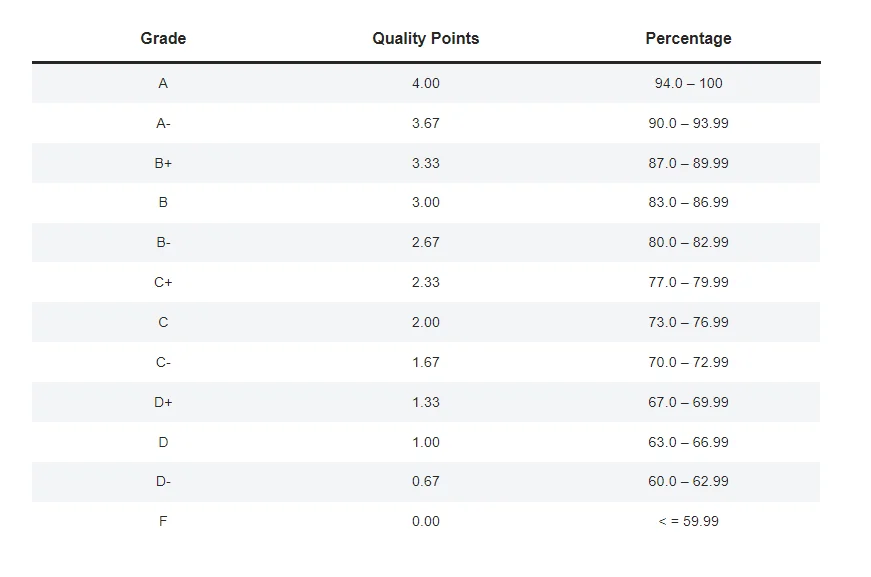
Textbooks and study materials
Regarding study materials, the American approach differs from the Indian approach. In the American education system vs Indian, students typically only need to carry a few books to school. Few books are followed, and many are kept within the school premises, especially in lower grades. In early grades, American school years from kindergarten onwards, the focus is on teaching children how to learn through creative and engaging activities that connect to real-world problems. Students learn fundamental subjects such as Math, language, and science through practical applications.
In contrast, Indian students often carry multiple books to school daily. The Indian education system tends to be more strict and places a heavier emphasis on homework. Pressures begin early in Indian schools, creating an environment where students face increased expectations and workload. Is the Indian education system harder than the American? This common question highlights the different demands placed on students in each system. The USA vs India education system reflects these divergent approaches to various aspects of education, ranging from class sizes and dress codes to assessments and exams. These differences shape the overall educational experience for students in each system.
We can say that the US education system vs India has distinct approaches, with Indian education focusing on rote learning and specialization. In contrast, the American system focuses on hands-on knowledge, creativity, soft skills, and well-roundedness. Is American education harder than Indian? Opinions vary, as each system emphasizes different skills and strengths. However, implementing India’s new National Education Policy (NEP) 2020 marks a transformative shift. Understanding these differences contributes to a broader understanding of whether US education is better than India and the varied philosophies behind each educational system.
Additional points:
Teacher-Student Dynamics
- India: The teacher-student relationship is often hierarchical, with teachers seen as figures of authority. Students are expected to be respectful and obedient, with limited scope for questioning or open dialogue. This can create an oppressive environment and limit student engagement.
- USA: The American system fosters a more interactive environment. Students are encouraged to ask questions, participate in discussions, and express their opinions. This fosters critical thinking and a more collaborative learning experience. However, this approach can sometimes lead to a lack of discipline and respect for authority.
Accessibility and Equity
- India: Access to quality education remains a challenge in India, particularly in rural areas. Public schools often suffer from overcrowding and inadequate resources. Private education, while offering better facilities, comes with a hefty price tag, creating an uneven playing field.
- USA: While the American system boasts high literacy rates, disparities exist based on socioeconomic background and geographical location. Public schools in underprivileged communities often need help with funding and resources. However, the availability of scholarships and financial aid helps bridge the gap for some students.
Challenges and Reforms
- Accessibility and Equity: Both systems face challenges in ensuring equitable access to quality education. India tackles the immense task of educating a vast population with limited resources, while the US grapples with issues of funding disparities and underperforming schools.
- Rote Learning versus Critical Thinking: While India’s rote learning approach has produced high-scoring students, critics argue it fosters a lack of critical thinking and practical skills. The US system strives for a balance between rigorous academics and fostering creativity and critical thinking.
- Evolving Needs and Adaptations: Both systems face the continual challenge of adapting to a changing world and preparing students for future careers. India’s implementation of the New Education Policy (NEP) 2020 signals a shift towards holistic learning and skill development. American education constantly debates reform measures to address issues like rising costs and student debt.
Conclusion
The educational systems in India and the United States differ in many ways, each with its unique strengths and challenges. The comparison of the American school years with the Indian system often sparks debates, such as “Is the Indian education system harder than American?” While the US education system vs India shows variations in structure and focus, both systems aim to equip students with the necessary skills to succeed in life. Questions like “Is American education harder than Indian?” and “Is US education better than India?” continue to fuel discussions about which system better prepares students for the future.
Moonpreneur is on a mission to disrupt traditional education and future-proof the next generation with holistic learning solutions. Its Innovator Program is building tomorrow’s workforce by training students in AI/ML, Robotics, Coding, IoT, and Apps, enabling entrepreneurship through experiential learning.
.

























Is CBSE harder than American school?
Both systems are almost similar, but India emphasizes challenging mathematics, while the US focuses more on complex English language education, offering greater depth across subjects.
Is it hard for an Indian student to study in the USA?
Adapting to a new education system, cultural norms, and social dynamics can be challenging for any international student. Indian students, in particular, might encounter specific difficulties with communication styles, learning methods, and social interactions.During my school days, we had no enrichment or extracurricular activities. After school, we would simply return home with a lot of homework.